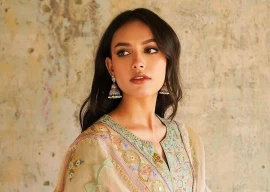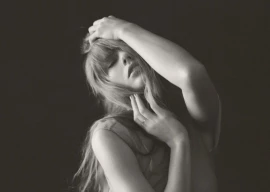
The procession also comprised of people riding on camels, bands and the Burhani Ambulance Corps. They arrived at the mosque amidst rousing cheers to commence the mass weddings, known as “Rasm-e-Saifee.”
The ceremony takes its name from the founder of this tradition, the late Syedna Tahir Saifuddin, the father of His Holiness Dr Syedna Mohammad Burhanuddin (TUS) who is the spiritual leader of the Dawoodi Bohra community.
This practice was established around 50 years ago to avoid heavy wedding expenses. The event itself is a consequence of the happiness of another upcoming event, the 101st birthday of the 52nd Dai-el-Mutlaq of the Dawoodi Bohra community, His Holiness Dr Burhanuddin, thus it is believed that the weddings on Rasm-e-Saifee have higher benedictions bestowed upon them.
Around 41 couples tied the nuptial knot in the presence of family and friends.
All the women wore colourful ridas (Bohra-syled abayas) but the brides could be distinguished by their expressions of excitement, tinged with nervousness, and the tikas or matha pattis (jewellery) on their foreheads. The bridegrooms who dotted the mosque were easily distinguishable with their golden turbans, called feta, with the single white feather, known as kalgi.
In their white embroidered sherwani, they took turns to go up to the stage, where Janab Norruddin Bhai Saheb, the president of Dawoodi Bohra Jamaat of Karachi, solemnised their nikkah. After each nikkah, a Bohra-styled golden sehra was tied to the head. Each bride was led to a garlanded chair on the first floor and covered with a red sequined dupatta while she watched her husband-to-be say his vows on the ground floor. After that they were smothered with hugs and congratulated while the organisers called to the next bride.
After each nikkah, each couple was given a present by the community - a rida and a purse for the bride, and a thaal, a kundli and a chillum chilottia for the bridegroom. A thaal is a very large round tray out of which the Dawoodi Bohras traditionally eat, the kundli is its stand and the a chillum chilottia is used to wash the hands of guests sitting around the thaal. The community not only gave gifts but also provided for the stage decorations, a photographer and video making facilities. After the nikkah refreshments were offered in the traditional style.
As one of the bridegrooms, Ibrahim Shabbir, made his rounds of hugs and congratulations, I asked him why he had opted for the Rasm-e-Saifee. “It was a family decision for me … the facilities offered made everything convenient and easy.”
While for a new bride, Mrs Shabbir Abbas Sodawaterwala, her mother-in-law put the idea forth and so far the experience had been great. Another, Fatima Burhan, smiled as she brushed tears away from her eyes. “Being a part of Rasm-e-Saifee means that I have all the blessings of Syedna Burhannuddin (TUS),” she said, as she moved on to accept felicitations from the people.
Published in The Express Tribune, March 12th, 2012.
COMMENTS (11)
Comments are moderated and generally will be posted if they are on-topic and not abusive.
For more information, please see our Comments FAQ



































@ Ali Tanoli: Dear friend, you are right we all are under the same umbrella of islam, Muslim is the name chosen by Allah for us. I think this bohra is an Farsi word meaning Business man, and in Arabi it means the one who innovative. Its just an group identity just like we select our family names. I dont think its an issue. was Salam
bohra community is the best community in this world.
this was so interesting! thank you so much...living far away from pakistan / india i had never heard of this sect. Love learning more about other religious rituals! thank you!
@Shabir Hussain I dont wanna be called any thing else than just Muslim the name God chose and Muhammad Gave to me and i dont wanna be seprate than any other muslim is the world i want when i go to Brunai far east, Egypt, Iraq, palestine, Morroco or spain i can pray in normal mosque with Normal and true muslims and true islam which Muhammad brought for us.,
@MA:
yes,hate by the religious fanatics of the different sects towards the secular segment of society.
Had this mass wedding been arranged by any other religous party, the tone of the news would be other way.
May the couples lead happy lives.It's time the leader of the bohri community issues an edict for his followers to stop practising female genital mutilation on their daughters.It needs to come from the most revered and respected person in the bohri community,this order needs to come from the syedna himself.following is a petition by a bohri woman who has been creating awareness over FGM in the bohri community:
http://www.hindustantimes.com/India-news/Mumbai/Bohra-women-go-online-to-fight-circumcision-trauma/Article1-779782.aspx
Then you say there is no freedom for minorities in Pakistan !
Hate, that is the biggest problem with our society. Congratulations to the Bohra community.
@ Ali Tanoli, Call this community any name you may want. But learn somethings from them which I suspect you may not know before. Here are some; There is no concept of Dowry in Bohras. No matter weather you'r rich or poor,if you'r family of bride, you don't have pay a single penny as dowry. Literacy is 100% in Bohras They don't give and take interest in their business trasactions. In other words, they believe in interest( Riba, Sood) free business. And guess what, they are one of the most successful business communities in Pakistan and elsewhere.